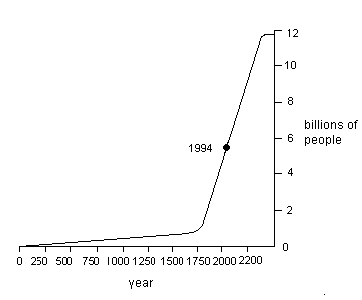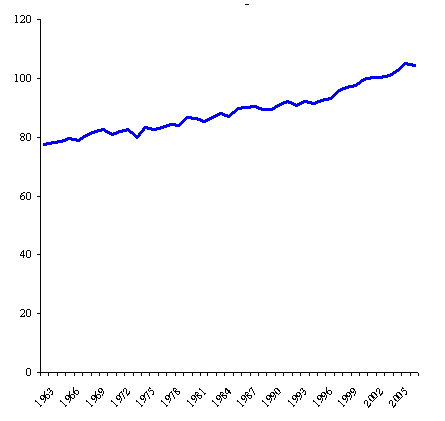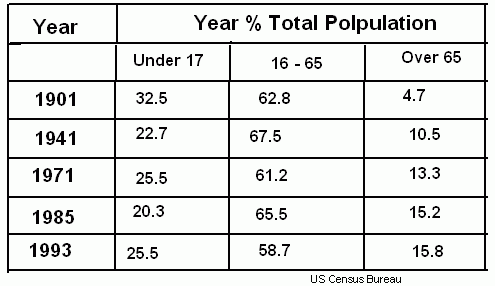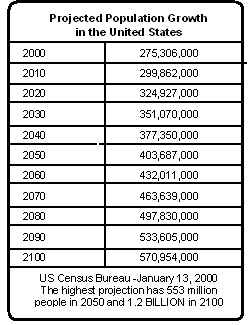Abstract
The report is about to prepare a comparative study of How overpopulation affects our Economy. The population is a mandatory part of the Economic activities. For sound economic growth, it is necessary to keep the population at an optimum level. Population more than an optimum level is called overpopulation. Overpopulation causes an increase in consumption, increasing consumption causes a decrease in saving, and decreasing savings results in decreased investment. Reduced investment results reduced employment opportunity and create unemployment. As a result whole GDP goes down. Thus, the economy always demands and optimum population.
Introduction
The world population has increased dramatically in recent years. According to the United Nations, it reached one billion at the start of the nineteenth century. By 1950, there were over 2.5 billion people on the planet. Since then the total has been doubled, to 5.6 billion this year. Long-term projection suggests that the number will carry on growing until after 2200 when the population will stabilize at around 11.6 billion – more than twice as many as there are now.

Despite the rapid growth of the world population, not all countries have experienced rapid growth of population. In particular, it is the world’s poorer countries, which have experienced the greatest growth of population.
Methodology
For evaluating the comparative study several topics have been choosing. These are: population dynamics and the demographic concept, reasons for the increase in the size of the population, effects of overpopulation in the economy, food production per capita index, lower national income, increasing burden on working population, the balance of payments difficulties, overpopulation illustration of Malthus and growth of population in united states has been presented to evaluate the effects on overpopulation. This report would enquire the relation between population and economic growth. This has been done with a review of existing theoretical presentation and imperial analysis. The focus has been drawn on fertility, consumption, and investment.
Population Dynamics and the Demographic Concepts
The developed countries such as the United States are very strict about birth control resulting in lower birth rates. Besides, later ages of marriage and the desire of many women to look forward to their careers, etc. lead to steady growth in the birth rates. An increase in the birth rate occurred mainly in third world countries, due to a decrease in infant mortality rate. This has been made possible due to medical improvements, the availability of more hospitals, etc. Lack of family planning and health education in communities resulted in higher birth rates. Besides, if the number of women of childbearing age is more in an economy, there is the likelihood that there will be a higher birth rate. However, initiatives of government could make it possible to control birth rates.
In the United States, the death rate has continued to decline throughout the twentieth century. The decline in the death rate has been a major contributory factor in the increase in the population. Factors that have tended to decrease the death rate in the US and other developed countries include improvements in the standard of living, improved working conditions, development of welfare state and improved medical techniques, better public health, and sanitation, better-educated population, and so on.
Rapid traditional immigration has taken place mainly in the USA, Canada, and Australia. There has been a new trend of immigration as people from India, Pakistan, African countries, and West Indies, come to these countries. An increase in net immigration has a great impact on the overpopulating USA and other developed countries. However, the US government is taking measures to restrict immigration.
Effects of Overpopulation in the Economy
Where a country has chronically overpopulated an increase in population may mean severe hardship poverty, malnutrition, and high death rates. An increase in the death rate will put a great strain on a country’s social, health, and educational facilities. Lack of pure water supply will result in rapid transmission of diseases. There may be overcrowding in houses, shortages of doctors, shortages of medicine, shortages of schools and teachers, and food shortages.
Food Production per Capita Index
Due to overpopulation, the per capita index of food production seriously hamper and brings a negative effect on the national economy. US government is much more aware in this regard.

African countries like Sudan, Ethiopia, Congo as well as some of the South Asian countries are already suffering from these problems. According to United Nations, more and more people are going to starve in poorer nations.
Lower National Income
The optimum population is the level of the population where national income per head of the population is maximized. This means that the population is at its best size and is achieving a level of national income (or output) that is at its best given to that level of population. GDP per head is the most frequent indicator used to calculate the economic growth and living standards in different countries. If a country is overpopulated, it means that there are too many people with few resources to provide a level of national income, which maximizes national income per head. If the increase in the population exceeds its optimum size then there will be too many people in the country. National income per head will be lower than it should be because there are not enough resources available.
Increasing Burden on Working Population
People over the age of 65 are part of the dependent population. If the increase in population is mainly on dependent age groups, the burden overworking population will be increased. This means that they will rely on the working population to produce goods and services they require and to pay taxes to finance old people’s homes and old-age pensions. Thus an aging population puts an increased burden on the working population. Of course, the working population could be increased by lowering the school leaving age and by raising the age of retirement to above 65 years.5 However, both these developments are extremely unlikely for social and political reasons (for example, unemployment would be increased). The table below shows the percentage of working and dependent age groups in the US from 1901 to 2000:

Immobility of Labor
An increase in population on dependent age groups will create immobility of labor. As people become older, they become less geographically and occupationally mobile. This may have a bad effect on the economy, as the new expanding industries will find it difficult to recruit suitable workers whereas the declining industries will make people unemployed who then do not move to another job or another area. Besides, increasing growth of population than that of the industries may result in both unemployment and underemployment. In 2000, the population of the United States was 282 million, out of which 81 million people were under the age of 17, and 35 million people were of age 65 and above 65. So, there were about 116 million dependents out of 282 million, assuming that the rest 166 million were working population. Now, United States is facing severe shortages and immobility of the labor force.
Balance Of Payments Difficulties
An increase in population will have an enormous increase in the rate of consumption, resulting in more investment and fewer savings. A country may have a balance of payments difficulties because it may have to import more food and raw materials to satisfy the needs of its increasing population and industries than that of the exports. If the productivity of the economy is low due to the aging population, immobility of labor, and so on, then the visible import value may exceed the visible export value.
Overpopulation illustration of Malthus
One of the earliest writers on population was Reverend Thomas Malthus. In his Essay on Population, which was published in 1798, Malthus suggested a theory of population growth. Malthus’ theory was that the growth of population was limited by the means of subsistence. In other words, he believed that population growth was limited by the ability of the population to provide food, clothing, shelter, and so on for itself. He was concerned mainly with population growth in the UK and argued that population growth had a tendency to outstrip the growth of the means of subsistence. He expected that the production of food and the other means of subsistence would not keep pace with the growth of the population. In these circumstances, an increase in population would reduce the amount of food and shelter available per head. Continued population growth would therefore lead to poorer diets and event starvation for some people. The Spread of disease, famine, and death provided what Malthus called positive checks on the population growth. He believed that the existence of these positive checks would ultimately limit the growth of an economy’s population.
Cleary Malthus’ predictions have not proved to be correct for the developed world. The main reason for this is that the means of subsistence have in fact increased faster than population growth. In particular, Malthus believed that food production would not keep pace with population growth because as the population increased, land which was less and less fertile would be drawn into use and would yield a smaller and smaller increase in the output of food. In other words, Malthus felt that the law of diminishing returns would apply to the use of extra acres of agricultural land. In fact, in the developed countries there has been widespread and increasing use of fertilizers and pesticides,.and the adoption of highly mechanized means of production. Both these trends have raised the output per acre of agricultural land so much; so that the increase in the output of agricultural land has exceeded the needs of the increase in population.
However, the same is not true in the case of many of the world’s developing countries. Here, population growth has sometimes been at such a rate that Malthus’ predictions have unfortunately come true. Famine occurred in areas such as Ethiopia and Sudan. The relatively high death rates that characterize many developing countries are often due to the effects of poor diet. The lack of food and unbalanced nature of the diet in turn stems from the population growing faster than the means of subsistence.
Growth of Population in the United States
During 1994, nearly 2.0 million people were added to the total population of the United States. This was due to a decline. It is projected that at least 1.0 million people from these were immigrants. It is estimated that if the population continues to grow in such a way in the United States, it is going to reach 570,954,000 by 2100.

Due to the decline in death rates, the US economy may suffer from the curse of the aging population. Difficulties like the increasing burden on the working population and immobility of labor are going to decrease the productivity of industries. Thus, the US government may have to import more than that of the exports, resulting in a balance of payments difficulties. However, the government is taking measures to slow down the rate of immigration, which may have a positive impact on the economy.
Conclusion
The rapid growth of population causes Overpopulation. Overpopulation has a negative effect on economic growth in consideration to food production per capita index, lower national income, consumption and investment conflict, and increasing burden on working population and balance of payments difficulties. Thus for economic policymakers, it is most important to keep the population at an optimum level.
Bibliography
Burki, S. J. (2007), Asymmetric Demographic Developments: An Opportunity for Emerging Markets, The Inter-American Development Bank, EMP Financial Advisors, pp. 34-96.
US Census Bureau (2000), Population Dynamics in the United States, Sustainability Review: Issue 25, pp. 67-89.
Anderson, A. (2000), Economics, 3rd edition, Causeway Press, ISBN 190279619, pp. 111-152.
Maunder, P. et al (2007), Economics Explained, 6th ed., Collins, ISBN 0003277585, pp. 98-134.
Grant, S. J. (2005), Introductory Economics, 7th ed., Edinburgh Gate, Harlow, Essex, pp. 512-518., 582-588.
Hobday, I. (2005), Economics A First Course, 2nd ed., Hodder & Stoughton, London, pp. 230-280.
Stanlake, G. F. (1999), Starting Economics, 7th ed., Longman, London, pp. 232-250.